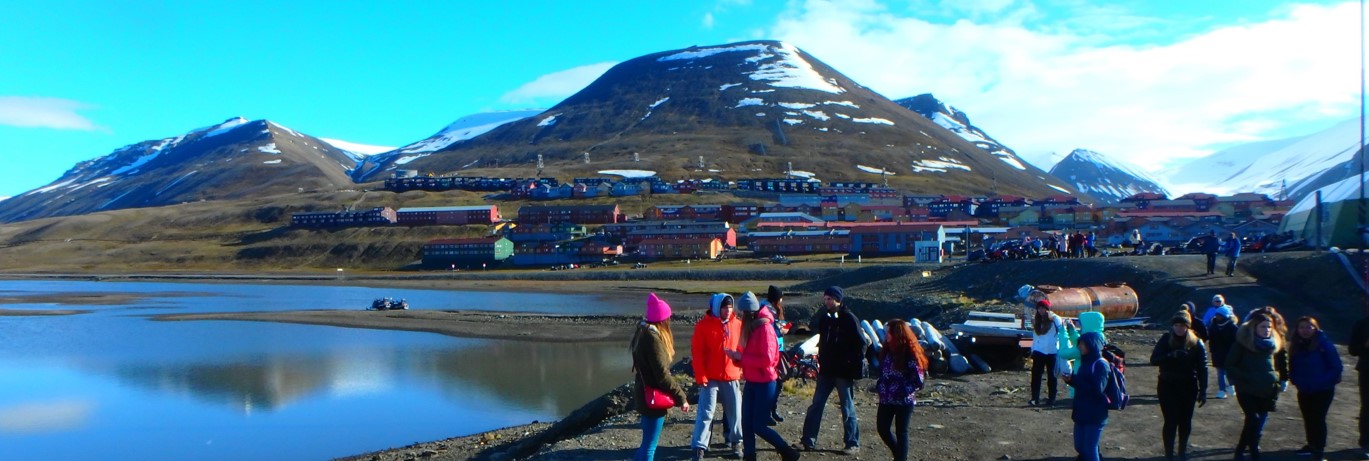Modern trace analytical methods in organic analytical chemistry allow for quantifying a multitude of anthropogenic pollutants in the environment. Recently, pharmaceuticals and personal care products (PPCPs) have been identified as pollutants in Arctic environments. Previously, many man-made pollutants in the Arctic were considered introduced into the Arctic environment via long-range transport from middle latitude source regions. However, PPCPs are introduced into the Arctic from local sources, mainly via agricultural use in husbandry or direct release from untreated sewage.
The Arctic region stretches over 14 million km2 from 66 ºN latitude to the North Pole. Within this vast region, distributed among the eight Arctic nations, there are only 13 million permanent residents, mainly in near coastal settlements, and roughly half are settled within the Russian Arctic. The scattered distribution of the settlements pose considerable challenges for establishing sustainable sanitation and water management. Drinking water supply as well as wastewater management in Arctic settlements are characterised by decentralised infrastructures and minimum treatment for drinking water and sewage.
Central water supply and basic waste water/sewage treatment facilities are currently only installed in large settlements (> 2’000 inhabitants). Most small settlements (< 2’000 inhabitants) are dependent on individual water supply systems, as well as individual wastewater and sewage treatment systems (i.e. Honey Bucket collection systems).
The lack of suitable water supply and treatment facilities in many regions and settlements poses a considerable risk for spreading infectious diseases, pathogens and anthropogenic pollutants, threatening human populations, as well as the environment.
The rapid environmental changes that are currently observed in the Arctic regions pose additional stress on infrastructure and require new routines and updates in water treatment and handling infrastructures. The continuous changes in the Arctic cryosphere (permafrost, icecap reduction, decrease in sea ice coverage) directly effect the integrity of the available infrastructure as well as the functionality of current treatment routines in the settlements. Thus, in the near future considerable changes are needed in technological solutions, treatment strategies and awareness of the individual Arctic inhabitants.
At the end of this lecture students understand that:
- Pharmaceuticals and personal care products (PPCPs) are identified as local pollutants in the Arctic
- The main source of PPCPs in the Arctic are sewage related release into the aquatic or/and the marine environments
- Minimum sewage treatment in combination with cold climate conditions prolonges the presence of PPCPs in the environment
- PPCPs can be considered indicators for the local anthropogenic influence on the Arctic environment.
AMAP Assessment 2016: Chemicals of Emerging Arctic Concern
This assessment report presents the results of the 2016 AMAP Assessment of Chemicals of Emerging Arctic Concern which was conducted between 2014 and 2016 by an international group of experts. The report updates the AMAP POPs assessments delivered in 1998, 2002 and 2009, specifically with respect to information on chemicals newly identified in the Arctic environment.
A Review of Wastewater Handling in the Arctic with Special Reference to Pharmaceuticals and Personal Care Products (PPCPs) and Microbial Pollution
Treatment of wastewater is often inadequate or completely lacking in Arctic regions. Wastewater contains different kinds of substances that can be harmful for the environment and human health, including residues of pharmaceuticals and personal care products. Bioaccumulation and biomagnifications of chemicals in the food web are of concern. This can affect fishery that is a significant industry in many Arctic coastal regions. Wastewater from human settlements may also contain antibiotic resistant bacteria and pathogens that can cause negative impacts on human health and the environment. In the Arctic, especially, the direct release of untreated sewage may have severe consequences for the receiving environment due to low biological diversity, low ambient temperatures and consequently high vulnerability of the Arctic ecosystem to environmental contaminants.
GUNNARSDOTTIR, R. et al. (2012): A Review of Wastewater Handling in the Arctic with Special Reference to Pharmaceuticals and Personal Care Products (PPCPs) and Microbial Pollution. In: Ecological Engineering: Volume 50 , 76-85. URL [Accessed: 16.12.2018]Pharmaceutcals in the Environment: Sources, Fate, Effects and Risks - second Edition
This book addresses the most important issues in the field of pharmaceuticals in the environment for the near future. Typical examples and abundant data are presented.
KUEMMERER, K. (2004): Pharmaceutcals in the Environment: Sources, Fate, Effects and Risks - second Edition. Springer Berlin Heidelberg URL [Accessed: 02.08.2018]Micropollutants in Wastewater in four Arctic Cities - is the Treatment sufficient?
The four Nordic cities included in the present study form a gradient both in climate, from oceanographic temperate in Tórshavn at 620 N to arctic in Tromsø at 69.70N, and in population, from less than 6000 inhabitants in Sisimiut to close to 120 000 in Reykjavík. The cities are different and far apart but products from the sea has been mainstay to the economy and societal development. Thus, the management of sewage from the municipalities must maintain a clean and healthy marine environment.
DAM, M. AUOUNSSON, G. POULSEN, H. BERG, I. KRISTENSEN, L. STENERSEN, J. JOENSEN, F. DAVIDSEN, V. PETERSEN, S. (2017): Micropollutants in Wastewater in four Arctic Cities - is the Treatment sufficient?. Copenhagen: TemaNord URL [Accessed: 02.08.2018]Pharmaceuticals and Additives in Personal Care Products as Environmental Pollutants
The report summarises the results of screening analyses of pharmaceuticals and additives in personal care products in presumed hotspots in Faroe Islands, Iceland and Greenland. The compounds analysed were hu- man pharmaceuticals that are administered to alleviate and cure symptoms and illnesses. Also, the study included analyses of compounds added to personal care products to increase their hygienic properties or shelf live.
Environment and Pharmaceuticals
A publication containing facts and reflections about how pharmaceutical products and pharmaceutical residues can affect our environment and, as a result, our health. Published in collaboration between Apoteket AB (The National Corporation of Swedish Pharmacies), Stockholm County Council and Stockholm University
Pharmaceuticals and Personal Care Products (PPCPs) in Arctic Environments: Indicator Contaminants for Assessing Local and Remote Anthropogenic Sources in a Pristine Ecosystem in Change
This first review on the occurrence and environmental profile of PPCPs in the Arctic identified the presence of 110 related substances in the Arctic environment based on the reports from scientific publications, national and regional assessments and surveys, as well as academic research studies (i.e., PhD theses).
PPCP residues were reported in virtually all environmental compartments from coastal seawater to high trophic level biota. For Arctic environments, domestic and municipal wastes as well as sewage are identified as primary release sources. However, the absence of modern waste water treatment plants (WWTPs), even in larger settlements in the Arctic, is resulting in relatively high release rates for selected PPCPs into the receiving Arctic (mainly) aquatic environment.
PPCP monitoring in the Nordic Countries – Status Report
Pharmaceuticals and Personal Care Products (PPCPs) are substances used by individuals for personal health or cosmetic reasons, and products used by agribusiness to boost growth or health of livestock. Personal care products, such as creams, detergents, deodorants, cosmetics, perfumes etc. are used in an increasing extent worldwide. These products contain a wide variety of chemicals, used either as an active ingredient or as an additive to improve qualities of the product.
The objective of this report is to give an overview of the results of PPCP monitoring in the Nordic countries, by identifying which com- pounds have been monitored, in which countries and if the are im- portant differences in the values detected amongst the Nordic countries. This report presents the results and does not intend to interpret the results.
The Fate Aspects of Pharmaceuticals in the Environment: Biotransformation, Sedimentation and Exposure of Fish
Pharmaceuticals are bioactive chemicals that are mostly released to the environment via municipal wastewater treatment plants. Although they are widely detected in surface waters, the environmental fate and exposure of biota are still largely unknown. The results in this thesis show that microbial transformation was more efficient under aerobic than anaerobic conditions, however large differences were found between three pharmaceuticals studied experimentally. Diclofenac was recalcitrant, bisoprolol partially biotransformed and naproxen readily biodegradable
Chemicals of Emerging Arctic Concern: Summary for Policy-makers
This policy summary refers to the most recent AMAP assessment which looks at a wide range of chemicals newly and recently detected in Arctic ecosystems. These ‘chemicals of emerging Arctic concern’ should be considered potential candidates for future research or monitoring and possibly for consideration under relevant global and/or regional regulations. In addition, these chemicals of emerging concern contribute to an even broader understanding of how Arctic pollution is changing.
Roberto Rosal: Emerging Pollutants in Treatment Plants
Canadian Perspective for the Removal of Micropollutants in Wastewater Treatment
Presentation held by Wayne Parker, Civil and Environmental Engineering, University of Waterloo, Ontario.



